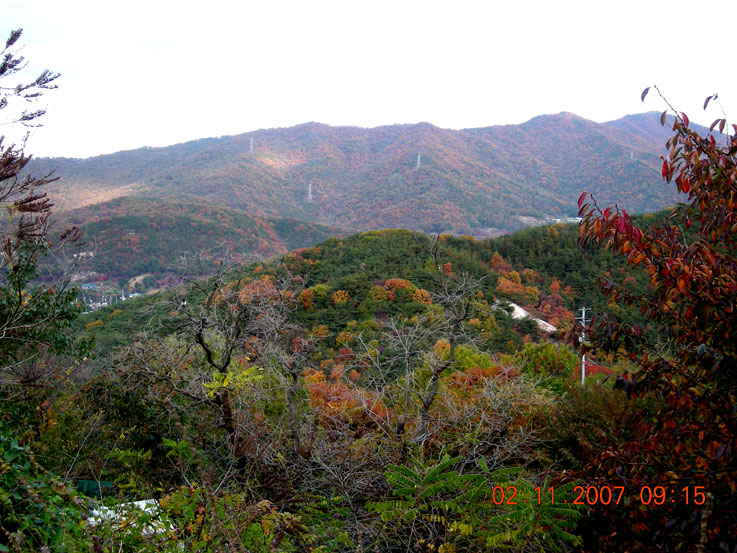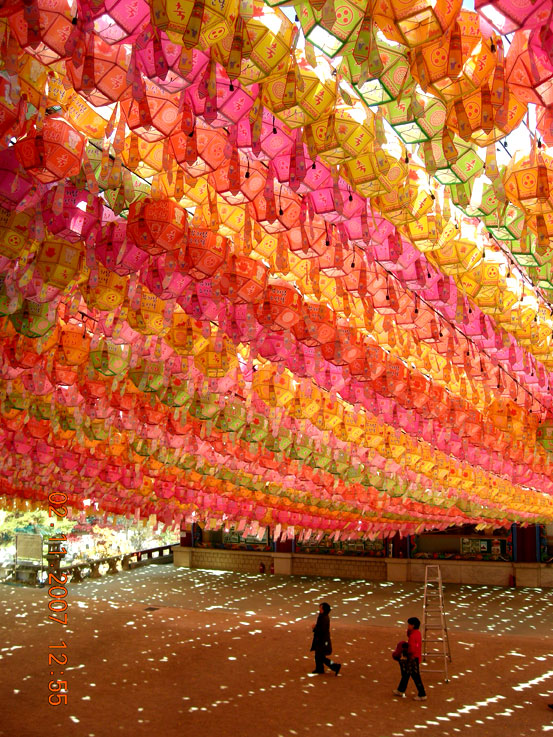 gorgeous peaks just minutes from downtown seoul.
gorgeous peaks just minutes from downtown seoul.
a couple of fridays ago i skipped school (again) to take advantage of the gorgeous weather, virtually smog-less visibility, and beautiful fall foliage. i wanted to go hiking in the mountains before the danpoong (단풍), or colorful leaves disappeared. after 20-minutes on the subway and another 10 on a local bus, i was walking towards bukhansanseong, the fortress wall where just one of bukhan mountain's many trails begins. foothills covered in colorful danpoong
foothills covered in colorful danpoong
bukhansan (aka samgaksan) has formed much of seoul's northern border since ancient joseon times. the name means "mountain north of the han river"... which it is. today, korea's oldest national park covers nearly 80 square kilometers and features 1,300 different types of plant and animal life. koreans love hiking, and the 5 million of them who visit annually make bukhansan the world's busiest, in terms of the number of visitors and park size. keep out!
keep out!
during much of the three kingdoms period (57 BCE - 668 AD), the bukhan area was hotly contested. an earthen fortress was built here in 132 during the reign of king kaeru of the baekje kingdom. he sought to stop the southward expansion of the gogurye. after a great battle against the mongols in 1232, japanese invasions from 1592-8, and another incursion by the manchus in 1636, in 1711 the joseon king sukebong greatly expanded the wall by constructing a stone fortification on top of the original fortress' ruins. at the time, the wall featured 14 gates, three command posts, 12 temples, 99 wells, 26 reservoirs and a temporary palace. today, the 12.7 km wall encircles more than 1,600 acres. four gates and the east command post remain. granite peaks with seoul's northern reaches below.
granite peaks with seoul's northern reaches below.
bukhansan's most popular photo-op is its dramatic granite peaks. the most famous is baekundae, which tops off at 836.5 meters. because it was a weekday, i avoided the lines of impeccably-dressed hikers who flood the park during weekends. for the most part i was alone on my hike, and in the quiet i could hear the faint chanting of buddhist monks whose temples dot the mountainside. on the final half-kilometer to the top, the smooth and steep granite surface necessitates hoisting onesself up via metal cables. after 2 hours of hiking and nursing a cramp-happy calf muscle, using my arms was a welcome change.
after summiting, i spent a while enjoying the spectacular view. seoul's northern areas were in clear sight. with minimal smog, you can see the han river winding through the city and you can even spy namsan and seoul tower in the distance. it's no wonder why that ubiquitous spire is a city symbol. while enjoying the view i saw a halmohnee (grandma) about 20 meters below me. she had chosen a rocky perch to bow, pray and make offerings of food. i've heard that part of korean shamanism includes communicating with mountain spirits. i'm not sure if that's what she was doing, but when she finished a good 40 minutes later, this woman in her late 70s or 80s, made her way gingerly down the granite mountain's face with a cane. it made me nervous. stone staircase
stone staircase
on the way down the leaves didn't disappoint. instead of taking the same route back, i talked with a couple of ajussi (middle-aged men) who recommended hiking down through a couple of beautiful valleys where orange, red and yellow leaves formed bright canopies over the stone steps and modest streams. as is typical with me, somehow i made one or two wrong turns and happened upon a large buddhist temple at the foot of the mountain. a ceiling of lanterns at doseon buddhist temple.
a ceiling of lanterns at doseon buddhist temple.
the doseon buddhist temple belongs to the korean jogye buddhist order. built during the second year of silla's king gyeongmun, faithful come here to pray for the nation's defense. the temple is well-known for a 30-foot tall image of the avalokitesvara bodhisattva that is carved on a cliff. it is said that dosunguksa (827-898), the national monk of his time, split a huge rock in half with a tap of his cane and created the image through his supernatural powers.
getting there:→ take subway line 3 to gupabal station (exit #1), then take city bus #704 to bukhansanseong. entrance fee is 1,600 won, but free if you arrive before the ranger station opens.
18 November 2007
field trip #3: bukhansan
posted by:
matt
at
19:32
![]()
topics: city life, field trip
Subscribe to:
Post Comments (Atom)
Archive
Labels
- city life (129)
- cityplan (8)
- expats (21)
- family (33)
- field trip (25)
- food (18)
- friends (61)
- history (3)
- holidays (27)
- home (30)
- homo (67)
- konglish (13)
- maps (5)
- me (85)
- miscellany (54)
- neighbors (22)
- north korea (5)
- ocd (35)
- plants (9)
- race (15)
- snapshot (23)
- the king (1)
- travel (48)
- usa (45)
- wacky (50)
- work (44)
- 한류 (korean cultural wave) (4)








1 comment:
well taken. absolutely breathtaking!!!
Post a Comment